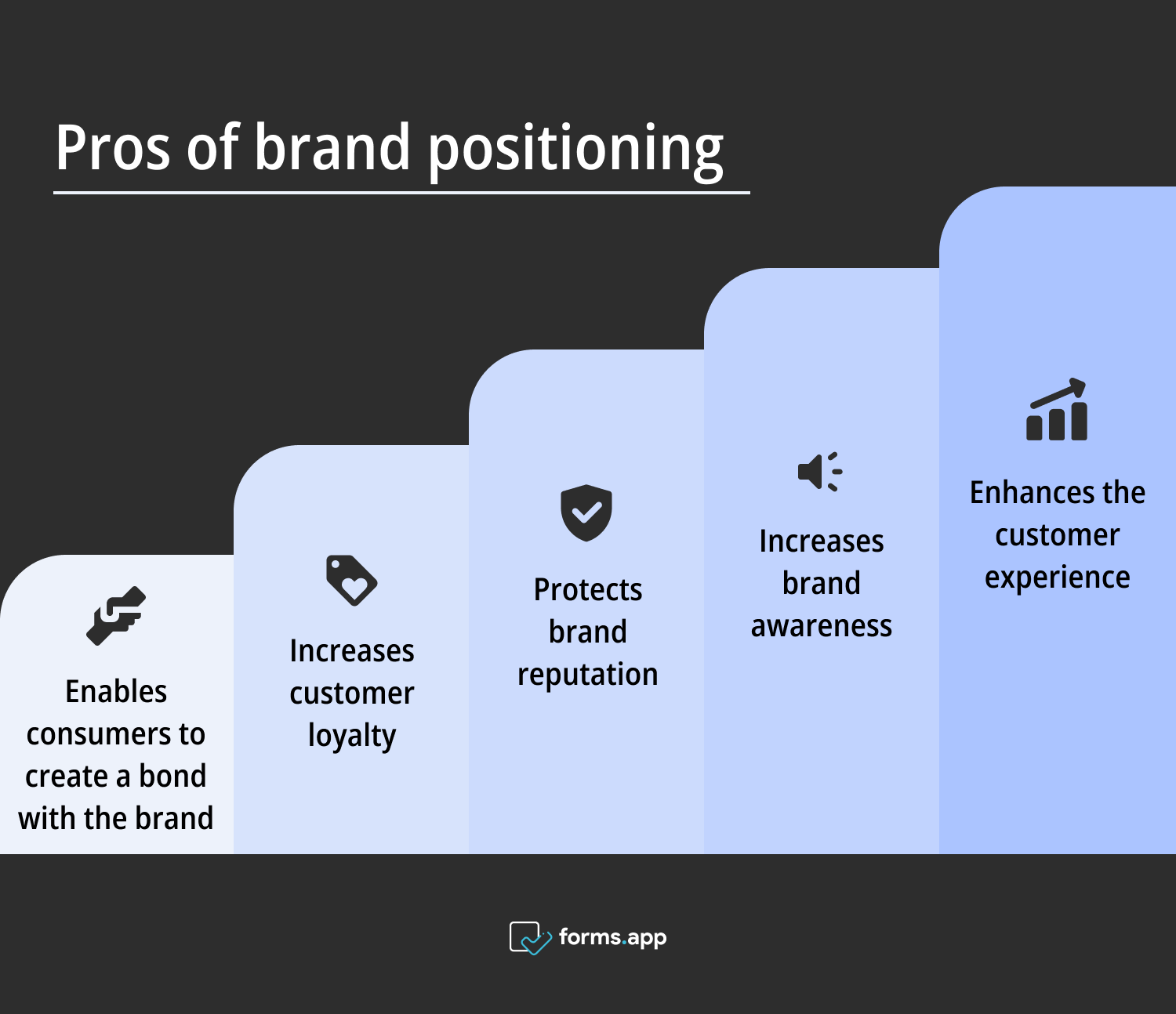
The spread of branding has also brought competition. Consumers choose from a wide pool of brands when purchasing a brand's products and services. Getting ahead in this competition is possible only if brands express their unique values to customers. You can introduce your brand to consumers and create a lasting impression on them through brand positioning.
Correctly implemented brand positioning strategies can help present a consistent image for your brand and communicate it to customers. Check out 20+ brand positioning statistics to learn what brand positioning is and how to implement it. The brand recognition statistics will allow you to benefit from the experiences reflected in them.
What is brand positioning?
Brand positioning demonstrates the unique values that the brand offers to its customers. It determines a brand's image, connotation with the consumer, and permanence. Brand positioning helps build brand identity. It differentiates you from your competitors and encourages consumers to choose your brand. In addition, the benefits of brand positioning for companies are as follows:

Advantages of brand positioning
- Enables consumers to create a bond with the brand
- Increases customer loyalty
- Protects brand reputation
- Increases brand awareness
- Enhances the customer experience
20+ Excellent brand positioning statistics to get ideas
Brand positioning strategy allows you to be aware of the wants and needs of the target audience while creating your brand identity. Thanks to the 20+ brand positioning statistics and marketing statistics we have prepared for you, you will be able to make comparisons and inferences. Now, let's move on to our eye-opening statistics that will help you:
1. Brand positioning equals brand awareness
A strong brand positioning strategy is a must for any company that wants to succeed, and the data shows you why. Marq notes that revenue increases for brands that are displayed consistently range from 10% to 20% on average.
To interpret this statistic, for potential customers, being familiar with a brand is a reason to prefer that brand. Therefore, brand awareness is a powerful tool for potential customers to be loyal to your brand. The way to increase brand awareness is through brand positioning.
2. Personalized services boost your sales
Brand positioning is the key to delivering personalized experiences to consumers. Epilson revealed that customers are ten times more likely to be a brand's most valuable customers if they think personalized services are appealing. They are expected to shop over three times more frequently and complete over 15 transactions yearly.
A correctly implemented branding and positioning strategy can communicate the brand's values to the customer. By doing that, you convey the message that your brand can meet the personal needs and expectations of the target audience. Therefore, if you do not give the necessary importance to brand positioning, you should reconsider your marketing strategies.
3. Brand positioning agencies are on the rise
With the understanding of the importance of brand positioning and branding, the number of companies operating in this field is increasing day by day. According to an impressive study conducted by Exploding Topics, the number of branding and positioning agencies worldwide was thought to be more than 10,000 in 2019.
The benefits of brand positioning statements for companies cannot be overstated. Identifying the target audience and providing the right products and services to that audience are just some of the issues that it helps companies with. Such benefits have led company owners to get professional support in brand positioning.
4. Brands that give customers trust are growing
When consumers choose brands to purchase from, they want the brand's values to match theirs. In addition, socially responsible brands are ahead of the competition in the industry. According to Gitnux, most consumers (31%) state that brand trust is crucial. Furthermore, 53% claim that before making a purchase, they need to have confidence in a company to do what is right.
You can express the brand's values and priorities to your potential customers through a brand positioning strategy and gain trust. By building trust with your customers, you can strengthen your brand's reputation and create customer loyalty. If you haven't considered a brand positioning strategy for your brand yet, this is the time to do so.
5. A consistent brand positioning creates a reliable brand image
Forbes proves that having a consistent brand presence across all channels might result in a 23% increase in revenue. A consistent brand presence ensures that customers accurately understand the service they will receive from the brand. Customers' recognition of the brand increases brand awareness.
Moreover, consistently delivering the brand's characteristics and values through different channels, such as various social media platforms, builds customer trust. A consistent brand positioning demonstrates the value of the brand by creating a solid and trustworthy brand image with potential customers.
6. Customers prefer brands they are loyal to, even if they are more expensive
There is a strong relationship between brand positioning and customer loyalty. Thanks to Yotpo’s survey, it is easier to understand the importance of brand positioning and brand loyalty. 36.5% of consumers stated that even if they can find cheaper options elsewhere, they will pay more for products or services of the brands that they are loyal to.
As you can see from the data above, brand loyalty greatly influences loyal customers' decisions. In addition, effective brand positioning aims to communicate the brand's values and unique characteristics. In this way, you can create an emotional connection between your customers and your brand and build brand loyalty.
7. With brand positioning, you can offer personalized experiences to your customers
A study conducted by Epilson in 2017 revealed the importance of personalization in brand positioning. An online survey of 1,000 consumers between 18 and 64 found that personalization is desirable, with 90% of respondents saying they find it appealing. Furthermore, 80% said they are more inclined to do business with a company that delivers personalized experiences.
Brand positioning ensures potential customers recognize your brand's features that differ from those of its competitors. It makes it possible for your brand to stand out from the competition in the industry. This allows you to offer consumers more personalized shopping experiences in your marketing efforts.
8. The success of a brand comes from building trust
Competition and the abundance of alternatives for customers to shop require brands to make extra efforts to be preferred by customers. One of the most significant factors that will put your brand ahead of its competitors is to gain customers' trust. According to Exploding Topics, 81% of consumers must trust the brand before making a purchase.
In this context, brand positioning's functions of creating a brand identity and differentiating your brand from your competitors come into play. Thanks to the brand identity and brand promise you create, you can be recognized more by your potential customers and inspire trust.
9. Your brand name is recognized through brand positioning
An impressive study done by G2 revealed that 77% of business-to-consumer buyers are inclined to make a purchase based on a brand name. Branding your product offerings and services and creating a name for your brand that customers recognize will give you a competitive edge.
Brand positioning will allow you to communicate your brand's unique values to customers and create a recognizable name for your brand. Getting your brand's name recognized is only possible if you consistently reflect the features that will make your brand stand out to consumers.
10. Originality is preferred by 61%
Customers' preference in a highly competitive market depends on the uniqueness of your product. Lee Goff demonstrated the importance of this with an interesting statistic. 61% of consumers are more likely to make a purchase from businesses that offer original content.
It is as important to convey this originality to customers as it is to be original in the products and services you offer to potential customers. This is where brand positioning strategies come into play. Brand positioning allows you to communicate your unique services and value to customers.
11. People buy from brands that they find interesting
Brand positioning aims to strengthen customers' bond with the brand. With effective brand positioning, your brand can attract customers' attention and create a desire to learn more about the brand. G2’s recent data showed that 68% of consumers enjoy reading about the brands they are interested in.
A well-executed brand positioning strategy emphasizes the brand's values and unique characteristics to consumers. In this way, your brand attracts attention, and your sales increase. Therefore, you should pay attention to reflecting your brand to your customers in an exciting way through marketing and brand strategies.
12. Customer experience is more important than the price
Brand positioning is critical for strengthening your brand's connection with its target audience and achieving success. Zippia found that 64% of customers believe the customer experience is more important than the price when purchasing. Positioning makes the customer experience favorable and encourages consumers to think positively about the brand.
In addition, consistent communication with customers through brand positioning ensures a better customer experience. Brand positioning ensures that the expectations of the target audience are correctly identified and met. You should implement brand positioning examples if you want your customers to have positive shopping experiences.
13. Having a consistent identity strengthens your brand
Effective implementation of a brand positioning strategy leads to a significant increase in revenue. You can see the contribution of brand positioning to economic growth with the statistics found in Crowdspring's research. It shows that revenue increases for brands that maintain a consistent identity range from 10% to 20%.
Lacking a consistent and clear identity for your brand can undermine its value. A well-executed brand positioning strategy can win consumers' trust by clearly articulating the brand's characteristics and values. It can also increase consumers' loyalty to the brand and make it more popular.
14. People choose brands with which they share common values
A brand positioning strategy clearly presents the brand's values to consumers. It is crucial for consumers to have shared values with the brand whose products they will buy. Gensler notes that 87% of customers tend to choose brands that share their beliefs, while 71% of them tend to avoid companies that do not.
The identity you present to consumers through brand positioning plays a vital role in their acceptance of the brand. This is how consumers see your brand as more than just a place to buy products and services. The bottom line is that the right brand positioning strategy allows customers to connect emotionally with your brand.
15. Brand positioning allows you to express yourself as a brand
Brand positioning can minimize the possibility of your brand being misinterpreted, which could harm your reputation. This makes it an essential strategy for a lot of businesses. According to Capterra, 57% of marketers have seen negative or defamatory social media comments about their brands.
In addition to the products and services your brand offers, brand recognition shows potential customers the branding message and identity your brand embraces. Clearly articulating your brand's value and mission statement to the customer will eliminate misunderstandings and prevent you from being damaged by defamation.
16. Social media enables accurate brand positioning
Social media is one of the most critical aspects of branding and content marketing. Companies benefit from social media and social media advertisements in their branding processes. It enables customers to follow and communicate with brands and influences people's shopping decisions. Exploding Topics found that 77% of customers prefer to purchase from companies they follow on social media.
Because customers communicate directly with brands through social media, companies can use their brand positioning strategy to express the brand's values to them. In addition, this will increase your brand awareness and strengthen your brand identity. For this reason, you shouldn't ignore the impact of brand positioning and social media on branding.
17. Brand positioning determines how your brand is perceived
Brands' strategies for communicating with customers determine whether customers will choose the brand. The data from Gitnux's research showed us the importance of how brands reflect and express themselves. Research indicates that 45% of a brand's perception comes from its actions and presentation strategy.
Brand positioning determines your brand's direction and strategies, contributing to building a consistent brand image. How consumers perceive a brand depends on the efforts made in accordance with its positioning strategy. When determining your brand positioning strategies, remember that you also choose how customers see you as a brand.
18. Authenticity can be achieved through brand positioning
Stackla's survey of 2042 people in the United States, United Kingdom, and Australia showed the importance of brand authenticity. When choosing which brands to support, 88% of consumers say authenticity matters, and 83% of consumers think businesses should offer more authentic shopping experiences to customers.
Brand positioning is a way of expressing the unique service a brand offers to its target customers. With a brand positioning strategy used correctly, you can express the authenticity of your brand to your potential customers.
19. Brand’s values influence purchasing decisions
The specific values that brands reflect to the customers determine the attitude of the customers towards the brand. G2 revealed the relationship between brand values and customers with an interesting statistic. 62% of consumers say that a brand’s values heavily influence their purchasing decisions.
Your brand's values reflect its identity and how it speaks to customers. It is very important to be able to articulate to potential customers the values that distinguish your business from its competitors. This is possible with a correctly used brand positioning strategy.
20. Transparency builds customer loyalty
Transparency is an essential part of a brand positioning strategy. Communicating brand elements openly can increase customer trust in your brand. According to research by Lee Goff, a company that provides total transparency will likely win over 94% of consumers' loyalty.
Companies that have adopted the principle of transparency in their strategy inspire trust in customers. The way to increase customer loyalty to your brand is through transparent brand positioning. You should pay attention to brand positioning to create a positive image for your brand and increase your sales.
Conclusion
Well-executed brand positioning ensures consumer preference, loyalty, and connection to the brand. In this article we prepared for you, you learned about brand positioning definition and its benefits. In addition, our 20+ essential brand positioning and branding statistics provide an overall understanding of the topic and give you an idea of how to implement it.
Now that you have read our statistics, you can start implementing brand positioning strategies for your business!
Fatih is a content writer at forms.app. He is also a translator and interpreter. Fatih loves reading and writing. He is passionate about exercising and traveling. His specialties are surveys, statistics, and translation.



 11 min read
11 min read

